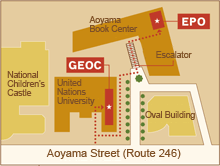Two governors’ summits focusing on the socio-ecological systems known as satoyama (terrestrial) and satoumi (coastal) landscapes were convened on October 19 and 20 in Nagoya by the United Nations University (UNU), the Global Environment Outreach Center (GEOC) and the Ministry of the Environment of Japan (MOE).
The summits showcased policy initiatives undertaken by prefectural governments in Japan to link the maintenance and rebuilding of satoyama and satoumi landscapes with biodiversity conservation and sustainable use to revitalize local communities. Following the launch of the International Partnership for the Satoyama Initiative earlier on 19 October, the summits were also intended to advance dialogue on the crucial role that regional-level initiatives focusing on biodiversity in human-influenced ecosystems can play in the implementation of the CBD. The events were intended as a first step towards the development of regional networks around biodiversity issues, providing the missing link between existing mechanisms for concerted action at the local and international levels.
Ahmed Djoghlaf, executive secretary of the CBD, attended both summits and expressed his appreciation for Japan’s policy-making initiatives focusing on satoyama and satoumi landscapes, which approach development and the environment not only as compatible but also as mutually reinforcing in the long run.
The Biodiversity Governors’ Summit on 19 October, a public forum organized in the heart of Nagoya City, was attended by approximately 300 people. Following the keynote speech by Kazuhiko Takeuchi, vice-rector of UNU, lectures by the vice-governor of Ishikawa Prefecture, Yoshiaki Nakanishi, the governor of Hyogo Prefecture, Toshizo Ido, the vice-governor of Shiga Prefecture, Uichiro Taguchi, the vice-governor of Shizuoka Prefecture, Shinichi Ohmura and the governor of Aichi Prefecture, Masaaki Kanda, introduced approaches, strategies and case studies related to biodiversity conservation and sustainable use of satoyama resources in their prefectures.
The governors’ presentations were followed by a panel discussion led by Kazuhiko Takeuchi, which brought together the participating governors and vice-governors with Atsuko Domoto, former vice-president of the International Union for Conservation of Nature (IUCN), Tsunao Watanabe, deputy director-general of the Nature Conservation Bureau of the MOE, and Anne McDonald, director of the UNU-Institute of Advanced Studies Operating Unit Ishikawa/Kanazawa.
The Satoyama Governors’ Summit on 20 October, a CBD/COP 10 side event, presented biodiversity-focused policies and initiatives by Japan’s prefectural governments to the international audiences assembled at COP 10, through lectures by the governor of Ishikawa Prefecture, Masanori Tanimoto, and the vice-governor of Aichi Prefecture, Etsuo Ogawa. The governors’ lectures were commented upon by Akiko Domoto, Tsunao Watanabe and Anne McDonald.
Concluding the side event, Anne McDonald announced that a Governors’ Summit message was being drafted and would be submitted to the CBD Secretariat together with case studies from each participating prefecture.
Download the summary Report of the Biodiversity Governors’ Summits (PDF 215KB)

















